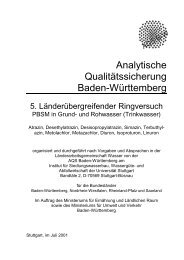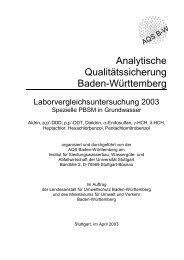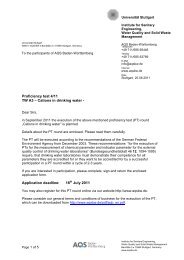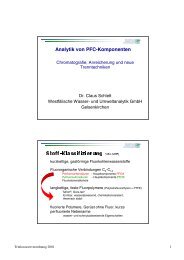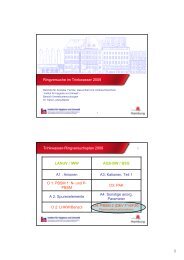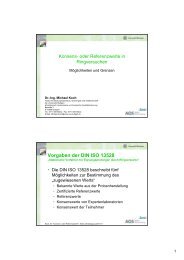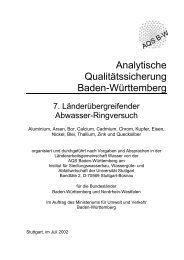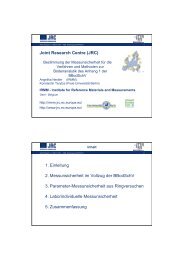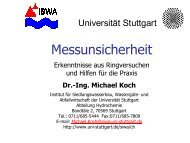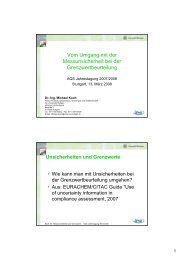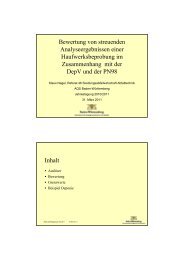Institute for Sanitary Engineering, Water Quality and Solid Waste ...
Institute for Sanitary Engineering, Water Quality and Solid Waste ...
Institute for Sanitary Engineering, Water Quality and Solid Waste ...
You also want an ePaper? Increase the reach of your titles
YUMPU automatically turns print PDFs into web optimized ePapers that Google loves.
Biological Air Purification ALR<br />
di-tert-butylperoxide, di-tert-amylhydroperoxide <strong>and</strong><br />
di-tert-butylhydroperoxide <strong>for</strong> example belong to this<br />
group. The feasibility of biodegradation of these peroxides<br />
occurring as waste air compounds in air streams<br />
generated in the production of these peroxides was<br />
determined in cooperation with consulting engineers.<br />
In literature different peroxidases able to cleave peroxides<br />
in general are described. Most of them are specialised<br />
in the degradation of hydrogen peroxides. Only<br />
some of them like horseradish peroxidase are adapted<br />
<strong>for</strong> the degradation of organic peroxides. Experimental<br />
studies, focused on the di-tert-butylperoxide, showed<br />
a poor biodegradability of this compound caused by its<br />
low solubility in water <strong>and</strong> a high sterical shielding of<br />
the ternary carbon atoms.<br />
Development of a capable waste air treatment<br />
concept to fulfill limit values of the TA-Luft 2002<br />
<strong>for</strong> emissions out of sewage sludge during sludge<br />
dehydration in belt drying systems.<br />
Even though using state of the art techniques <strong>and</strong><br />
optimising them, in most cases TA-Luft limit values<br />
cannot be passed. In cooperation with the industrial<br />
partner state of the art techniques were compared <strong>and</strong><br />
most promising ones were tested under realistic waste<br />
air conditions. Adapted techniques were identified <strong>and</strong><br />
core of further optimisation especially in the view of<br />
temperature effects, condensation effects, maintenance<br />
intervals (quick stops, maintenance stops) <strong>and</strong><br />
elimination of odorimetric loadings.<br />
Advisor: Dr.-Ing. D. Dobslaw<br />
Advisor: Dr.-Ing. D. Dobslaw<br />
Independent Studies, Master- <strong>and</strong> Diploma Thesis<br />
The bacterial degradation of Isophorone<br />
Isophorone is a major product of the chemical industries.<br />
In this work bacterial straines were enriched,<br />
which could use isophorone as sole source of carbon<br />
<strong>and</strong> energy. The yielded straines were identified, their<br />
degradation kinetics were examined <strong>and</strong> the best per<strong>for</strong>mer<br />
was selected <strong>for</strong> further experiments.<br />
To reveal the degradation pathway a transposon mutagenesis<br />
was per<strong>for</strong>med. Some knock-out mutants<br />
were identified. They were incubated with Isophorone<br />
<strong>and</strong> another carbon source (their isophoron-degradatio<br />
pathway was now defective – see figure), <strong>and</strong> the<br />
produced metabolites were analyzed with the GC-MS.<br />
Thilo Hurler (technische Biologie) 2009<br />
Supervisor: Dr. N. Strunk<br />
Independent Study<br />
Transposon mutagenesis:<br />
Upper row: One substrate (blue) is trans<strong>for</strong>med by<br />
4 enzymes (red) to a product (pink). Three metabolites<br />
(green) appear in the reaction chain. The enzymes are<br />
coded by structural genes (orange), they lie all in the<br />
same operon.<br />
Lower row: One of the structural genes is damaged<br />
by a transposon (cyan). Gene 2 is disrupted, enzyme<br />
2 is defective. There<strong>for</strong>e only one metabolite (green)<br />
is produced, which could be extracted <strong>and</strong> analyzed<br />
Isophoron (C 9<br />
H 14<br />
O)<br />
111




